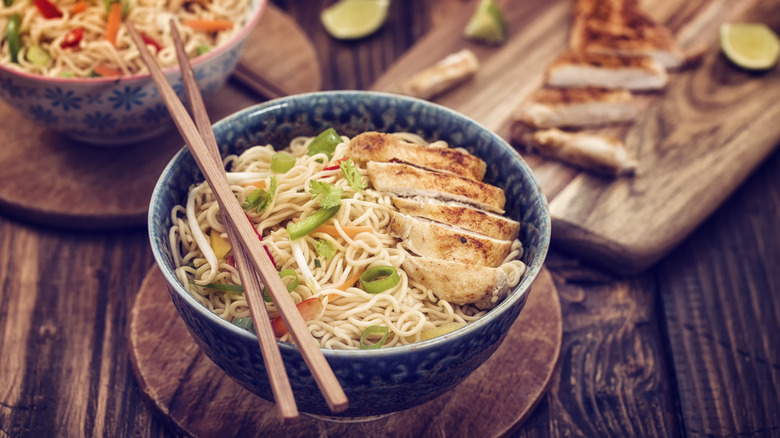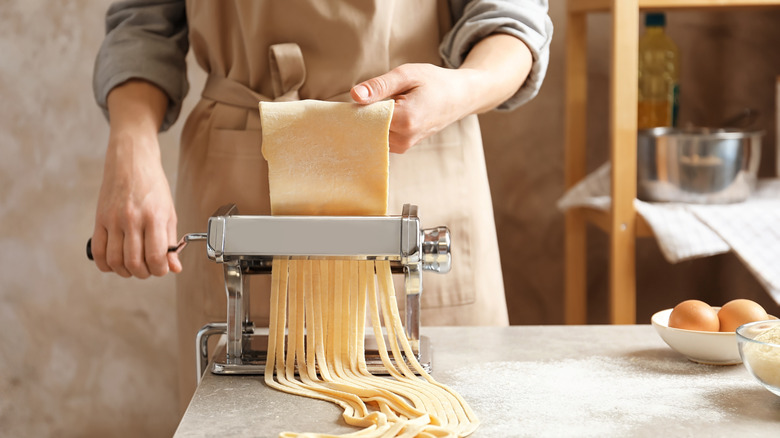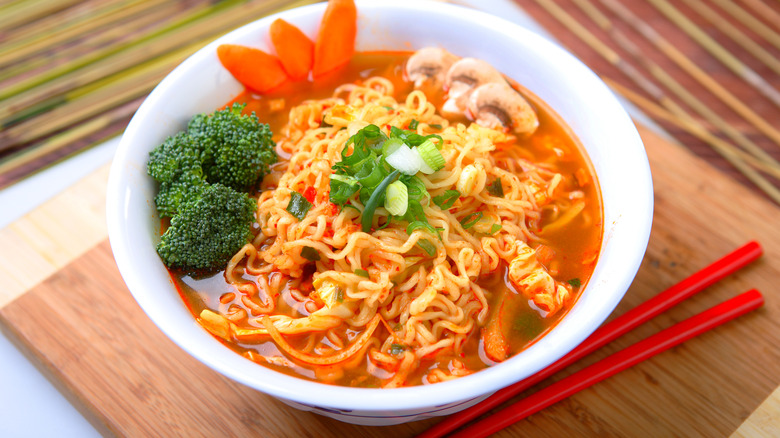The Rolling Tip You Need For Making Homemade Ramen Noodles
If you thought all noodles were made the same way, think again. Ramen noodles contain an alkaline ingredient, often kansui (a type of mineral water), giving them their unique texture. These noodles typically have an elastic quality that allows them to stretch without breaking, while remaining quite slick (which contrasts the starchiness of many other noodles). While these characteristics make for fantastic ramen dishes, they can pose a few obstacles to home chefs attempting to make ramen noodles from scratch.
For instance, the reduced water content in homemade ramen noodles can make rolling them out particularly challenging. That's why you must get the hydration level just right. Ensuring the dough has a water content of at least 35% (compared to the flour in the mix) is key to maintaining its integrity. Doughs with a lower hydration percentage often fall apart and can even cause issues with your rolling equipment. Aim to keep the hydration level between 35% and 40% to keep the dough intact when rolling.
Challenges of using pasta makers with low-hydration dough
A pasta maker is an essential kitchen tool for those who love to cook from scratch. Pasta makers are relatively affordable, highly versatile, and can even be used to make homemade ramen noodles. However, you'll likely encounter a few obstacles thanks to the differences between traditional Italian pasta and alkaline ramen noodles. Italian pasta is much softer and more pliable thanks to the dough's flour-to-egg ratio compared to the stiffer dough used to make ramen.
Ramen dough has a harder time traveling through pasta rollers because of its firmer texture. These rollers don't exert as much pressure as devices specifically designed for making ramen noodles. Ramen noodle makers are a bit harder to come by, as most are intended for commercial usage. And even if you could find one, it's likely to have a higher price tag than consumer pasta makers. While still challenging, you're less likely to run into obstacles with your pasta maker when ramen noodle dough has the ideal hydration. At 35% hydration and above, the dough will have a much easier time running through standard pasta rollers.
Recipes and pairings for homemade ramen noodles
After all the hard work of making low-hydration ramen noodles in your kitchen, you'll naturally want to enjoy a delicious and satisfying meal. In this case, creating a tasty broth is essential. A chicken-based broth can serve as the foundation of your dish, and ingredients like onions, scallions, and ginger will infuse it with more complex flavors.
While flavorful broth and perfectly textured noodles are essential in ramen dishes, you can't forget other delicious components. Umami-rich dried mushrooms (umami is the often misunderstood fifth flavor profile associated with rich, savory ingredients), shredded beef, nori, and soft-boiled eggs are all right at home in ramen dishes. You can also go the vegan route and replace the beef with tofu. As for flavoring agents, sriracha, chili sauce, and red pepper flakes can boost the spiciness to your preferred level. Making ramen noodles on your own is not the easiest undertaking, but the versatility and intense flavors of ramen dishes make the process more than worth it.


